Macarthur FC endured a curious 2022/23 season. Premier League legend Dwight Yorke was their manager to begin the campaign after guiding them to the Australia Cup in 2022 – their first major trophy ever – but struggled to get a tune out of the team as they won just five games and lost eight of their first 13 A-League games, leading to the club parting ways with him.
Mile Sterjovski, who acted as assistant manager to both Yorke and his predecessor Ante Milicic, took over in January 2023, but the Bulls’ form only took a nosedive as they won just two of their 13 remaining league games, shipping 30 goals and scoring just 15 in the process. They also crashed out of the Australia Cup in the first round, raising further questions about whether his time at the club might already be over.
However, Macarthur, who are the youngest team in the A-League at the moment (founded in 2018), chose to be patient and kept Sterjovski in charge. A flurry of summer activity followed as 12 players joined while nine departed. A few of these arrivals have made an instant impact as the club currently sit third in the 2023/24 league table with 28 points from 17 matches – two more than what they achieved in 26 games last term, just five points behind leaders Wellington Phoenix, who they host this weekend at the Campbelltown Sports Stadium.
Sterjovski has gotten the Bulls into the title race for the first time in their brief history by getting the most out of his attacking players and an excellent integration of new signings. This tactical analysis report will delve into how he’s done so by examining his tactics and performing some analysis on his style of play and key players so far.
Background
At 44, Sterjovski is just at the start of his managerial career. He has had two stints as assistant manager at Macarthur, while his only prior managerial gig was with semi-professional Northbridge FC, which lasted two years between 2021 and 2023.
However, prior to his current career, the Aussie enjoyed a near two-decade-long professional football career as a winger and midfielder. Sterjovski’s journey began at Wolves FC and took him all over the world, including multiple European clubs such as LOSC Lille, Basel and Derby County. He made appearances in the Premier League, Ligue 1, UEFA Champions League and UEFA Europa League (then UEFA Cup).
In fact, a large portion of his career was split across Basel and Lille, for whom he made a combined 248 appearances, recording 40 goals and 15 assists while playing with the likes of Eric Abidal and Ivan Rakitic. He won the Swiss League and Swiss Cup titles during his time with Basel as well. Sterjovski also made 42 appearances for Australia between November 2000 and March 2010, including three at the 2006 FIFA World Cup, and scored seven times.
He returned to Australia towards the end of his career, featuring for Perth Glory and the Central Coast Mariners between 2009 and 2014, with a brief spell in Turkey in between. Sterjovski won the 2012/13 A-League title with the Mariners before retiring at the end of the following season after a decorated career that saw him make 431 club appearances and record over a 100 G+A.
Now, he’s trying to bring that experience and title-winning mentality to Macarthur at a managerial level.
Macarthur: what’s changed from 2022/23 to now?
Formations and Personnel
A common trend across both the 2022/23 and 2023/24 seasons has been Macarthur’s tactical flexibility. Both Dwight Yorke and Mile Sterjovski seemingly preferred a 4-2-3-1 last season but were willing to change it up when required, using a 4-4-2, 4-4-1-1, 4-1-4-1 or even three-at-the-back system in different fixtures. This also indicated that the latter was still trying to figure out the formation best suited for his side.
This season, Sterjovski has been a little less flexible with his set-ups than last season, having received an entire pre-season with the squad. He has used a 4-4-2 in 34% of Macarthur’s A-League matches, 4-4-1-1 in 27% and a 4-2-3-1 in 23%. The former footballer is yet to use a single three-at-the-back formation, while the aforementioned set-ups have all largely utilised the same personnel.
Goalkeeper Filip Kurto has kept his spot from last season, starting all 17 of the Bulls’ league games this term. Tomislav Uskok has been a consistent feature at centre-back, with Matthew Jurman, Jonathan Aspropotamitis, and Oliver Jones all playing alongside him at different points this season. Ivan Vujica has made the left-back spot his own. At the same time, Yianni Nicolau has been the preferred right-back option, with Matthew Millar, originally a right-back, being deployed on the wing since excelling there in the final four games last season.
Kearyn Baccus and Clayton Lewis have started the most games in central midfield, with Jake Hollman also receiving minutes, while Ulises Dávila has operated as the 10. Raphael Borges Rodrigues has been the preferred option in left midfield or the left wing, with Jed Drew on the opposing flank. Upfront, the goalscoring burden has been placed on summer arrival Valère Germain, who has been up to the task so far, as we will see later on.
Sterjovski had many of the same options last season, with Kurto, Uskok, Vujica, Millar, Baccus, Hollman, Aspropotamitis and Drew all featuring in 10 or more of his 13 A-League matches in charge. Dávila played only four times but has become a prominent feature this time around.
In essence, Sterjovski has not improved this team’s fortunes through signings alone. Rather, a full pre-season with the team has seemingly got many of the players from last season playing in line with his vision and demands, while the summer arrivals have plugged the gaps the team had in his initial games in charge.
Positioning and statistical improvements
One of the critical changes Sterjovski has made this season is with respect to his team’s positioning, as indicated by the comparative heatmaps below. Macarthur now sits much deeper, as indicated by their increased passes per defensive action (17.41 in 2023/24 from 12.73 in 2022/23) — indicating a less intense pressing style — but they have emphasised quick build-up and hitting their opponents on the counter. This means they are more focused on impactful forward passes and taking risks in the final third rather than patiently waiting for an opening.
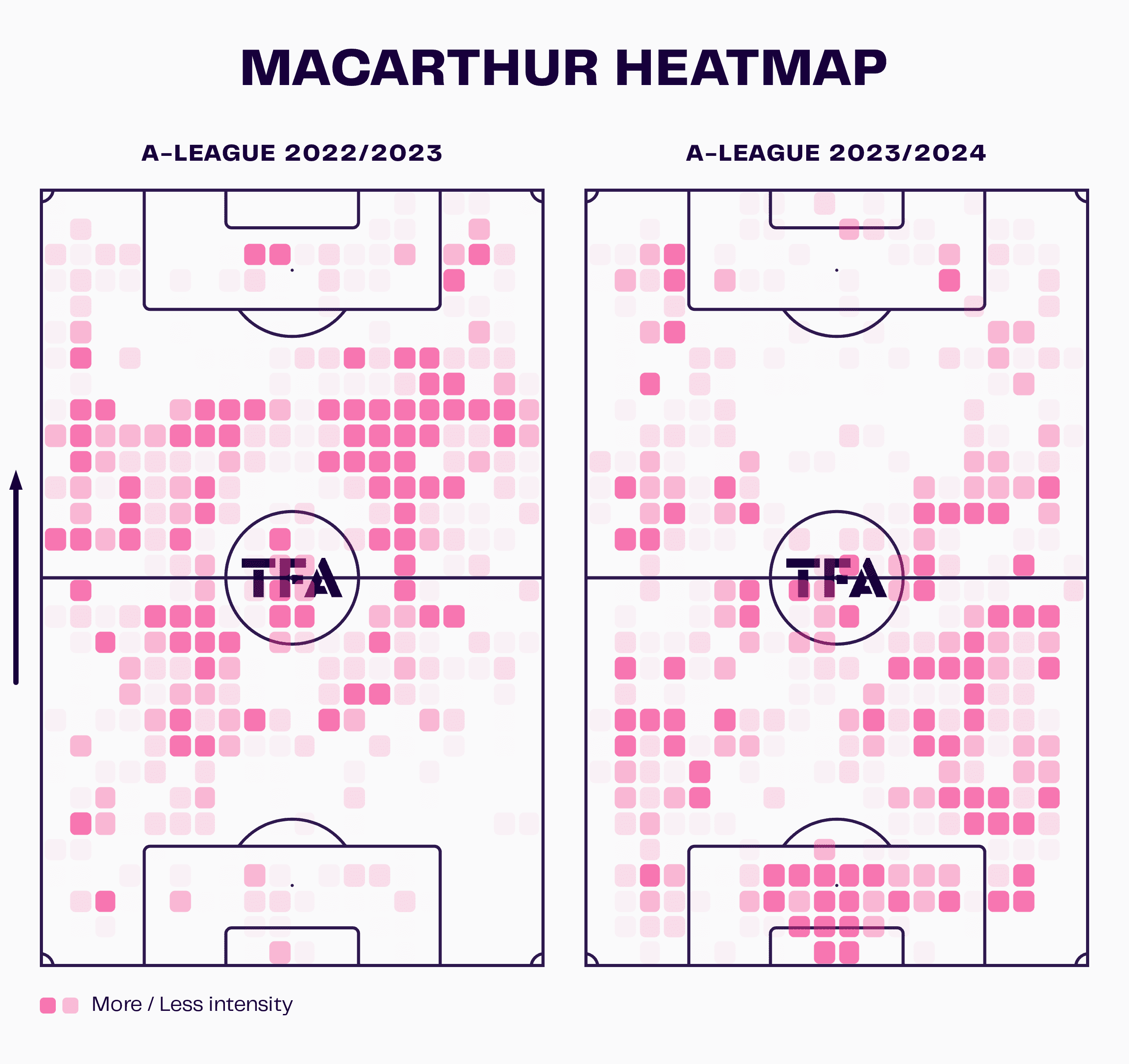
Their possession stats haven’t changed too much from last season (46.85% in 2023/24 vs. 46.15% in 2022/23). However, they are now constantly looking to pour men forward and move the ball quickly, resulting in improvements across various creativity and attacking metrics. As seen in the table below, Macarthur’s stats in numerous metrics, including shots, expected goals (xG), penalty area entries and multiple others, have improved from last season to now.
Interestingly, their average shot distance and long-distance efforts per game have both fallen, leading to more shots on target and, in turn, a greater xG. They are also making better use of different forms of attack, particularly counterattacks and corners, which we will touch upon later.
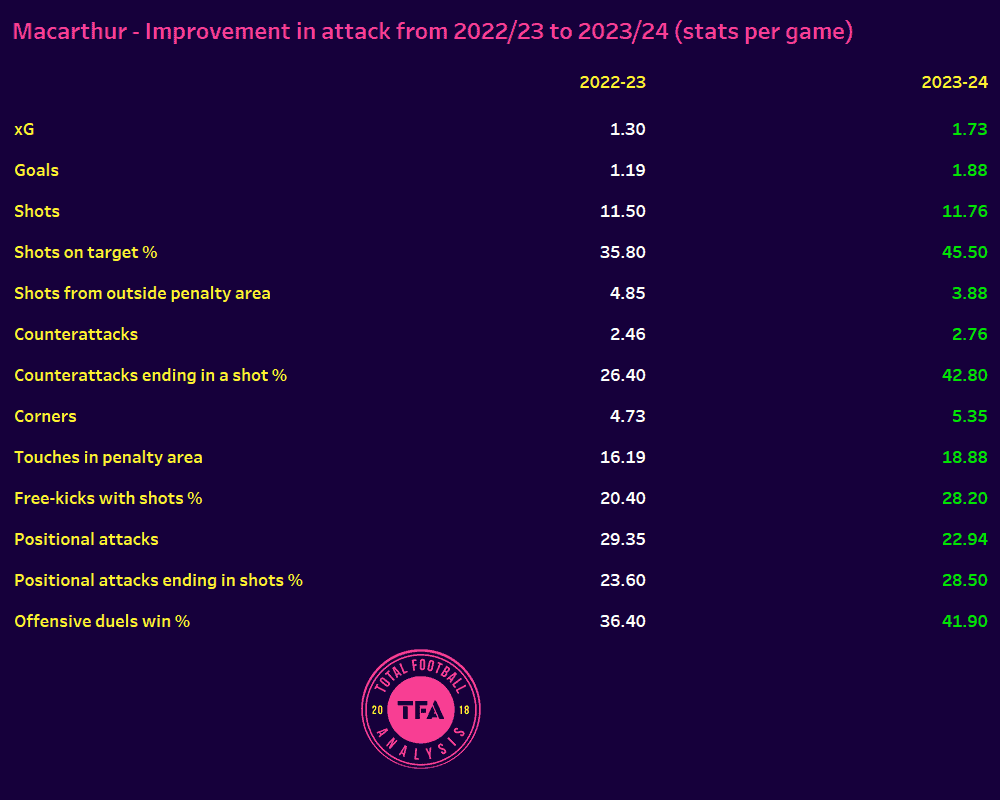
With respect to passing and creativity, Macarthur’s passing volume and accuracy across the pitch have both improved drastically despite the limited improvement in possession metrics. Their passes per possession is up as well, while only 8.95% of their passes per game are long passes (down from 11.25% last season), indicating once again that the emphasis is on short forward passes. The drastic improvement in the Bulls’ accuracy with respect to passing in the final third has been vital to their improved goals per game in the league.
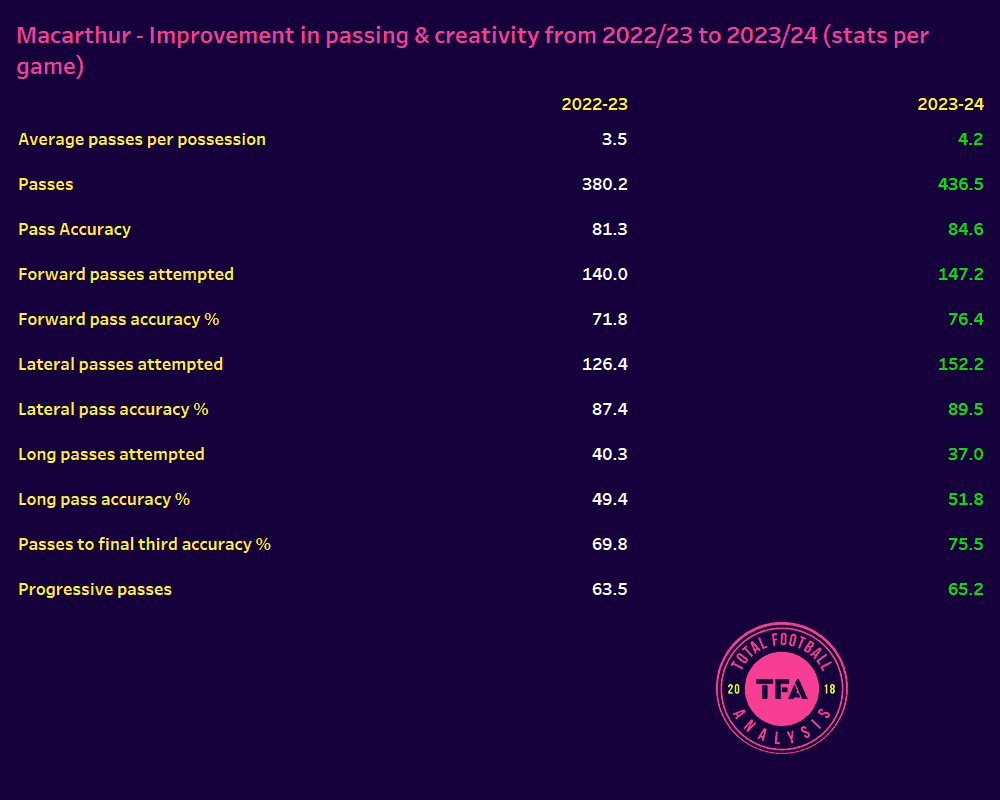
Macarthur’s attacking play: Quick build-up and deadly counter-attacks
As mentioned earlier, Macarthur’s attacking play this season has been predicated on actively moving the ball forward when they have possession rather than holding back and playing the waiting game. This has seen them take more risks, but these have been fairly calculated as well; their losses per game have dropped drastically from 109.35 last season to 97.65 this time around.
The snap below from their match against Western United provides a quick view of what their formation looks like when they have possession. Macarthur have a fairly high line, with both centre-backs playing near the halfway line. In this scenario, the left-back pulls back a little and drifts into a half-space in midfield, while the right-back (all four marked in white) stays higher but not too wide – this is interchangeable depending on which side the possession is concentrated in.
The left-winger and right-winger both operate out wide, with the centre-forward (all marked in black) hovering around between the defenders. One of the midfielders is just in front of the defensive line, while another is dropping towards the halfway line to look for a pass. The third midfielder (all three marked in blue) is in between the second and final lines of defence on the left, with space to turn into if he gets the ball.
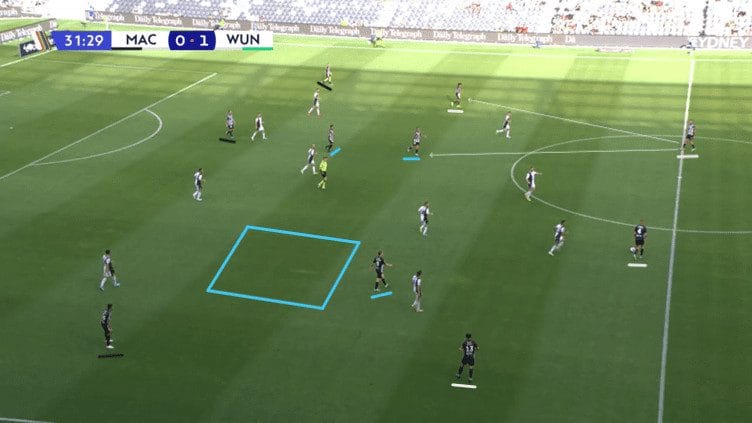
This is interesting in two key ways. Firstly, the manner in which Sterjovski sets up the team makes line-breaking passes fairly simple. The players seem to understand the principles behind their shape and have the license to look for the forward pass, making it possible to create and exploit spaces across the pitch. Secondly, this set-up allows Macarthur to load up on the flanks if needed, with the full-backs overlapping the winger or overloading the middle thanks to their three-man midfield and a centre-forward in Valère Germain (more on him later), who can run in behind the defence and come short as well.
This particular move resulted in a goal by Dávila, the midfielder furthest forward in the frame above, from distance after a pass from the back to the midfielder in front of him. The latter flicked it onto Dávila, who found the right-back. He returned the ball to Dávila, who had space and time to curl a shot into the far corner despite needing to strike it from some distance out.
There are other ways in which Macarthur’s tactical set-up have brought them goals as well. Consider the play below from their match against Western Sydney Wanderers, which starts with their goalkeeper, who passes to the left centre-back. He then plays it to the left-back, who promptly exchanges passes with the midfield to find Germain upfront. Germain smartly holds the ball up before slipping in Borges Rodrigues, who shows tremendous composure to get past a defender and the goalkeeper before scoring.
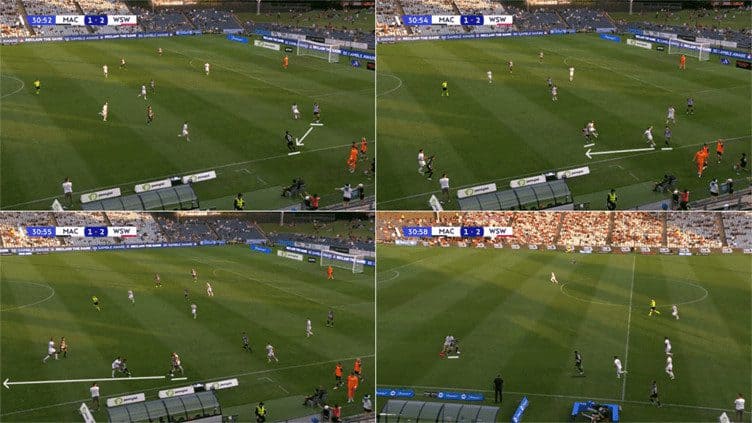
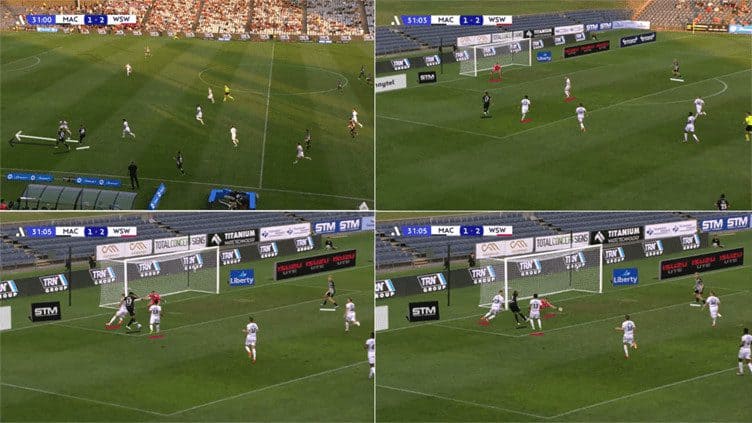
Notice that less than 15 seconds have passed on the clock; in that time, Macarthur have shifted gears and moved from defence to offence in a flash!
Macarthur do something similar in the sequence below as well against Perth Glory. They start in their own half before a switch from Baccus finds Borges Rodrigues in space again. He passes it to Germain, whose one-touch pass to Dávila is exquisite. The Mexican then dinks the ball over the goalkeeper to cap off a delightful team goal that took less than 15 seconds from one half to the other, giving the opposition very little time to react.
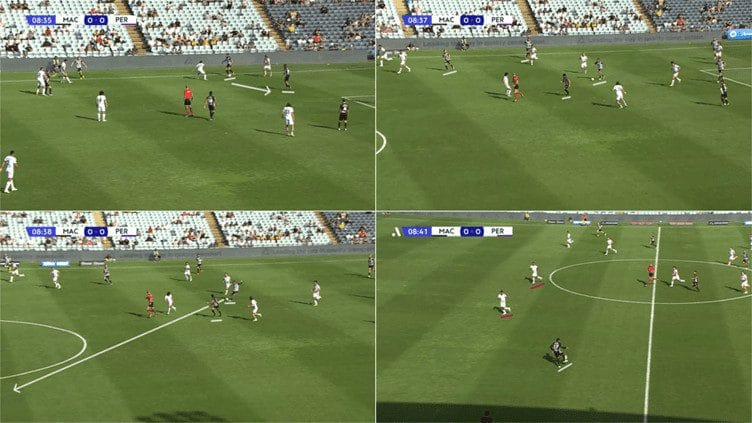
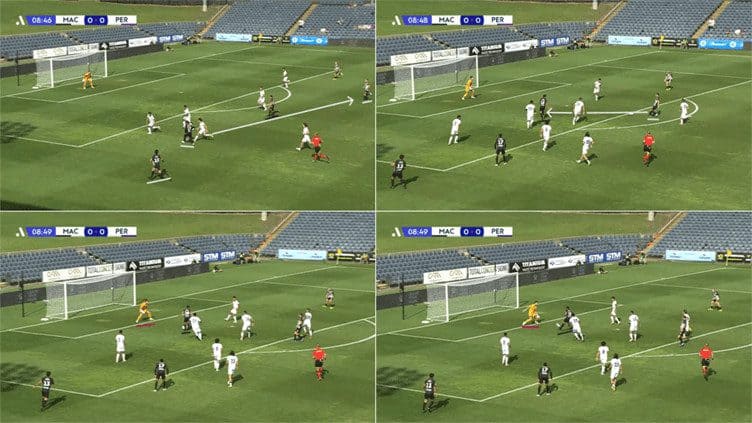
One last aspect to look at is their ability on the counter. As explained through the stats earlier, Macarthur’s efficiency from counterattacks has seen a massive improvement (42.80% of their 2.76 counterattacks per game ended in a shot). This has been vital to their chance creation and blends in well with their tendency to quickly move the ball to their attackers.
Consider the sequence below from their match against the Newcastle Jets. At the start of the move, Macarthur are content with sitting largely in their own half, with only two players pressing the Jets’ defence. While this allows Newcastle to outnumber them in their own half, the Bulls hold numerical superiority at the halfway line and beyond. What this also does is allow them to break forward at pace on the counter.
As shown below, Sterjovski’s set-up shuts down any space for the opposition in the attacking half, forcing them to go long. However, the pass is underhit and Macarthur’s players realise this fairly quickly – they begin making runs forward as the first pass is played by the intercepting defender.
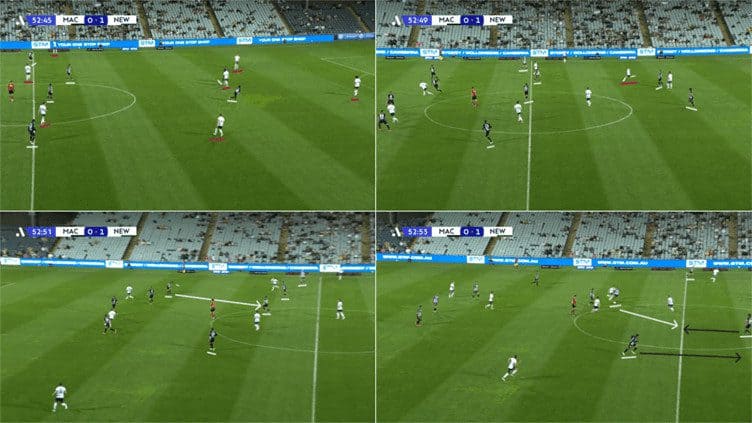
From here, a clever pass to the presser dropping back, a combination of numerous players charging forward, and an unsettled defence lead to an open pass on the right for Borges Rodrigues. Unfortunately, he makes the wrong decision and ends up firing his effort into the side netting from a narrow angle with two men waiting in the box. To the Jets’ credit, though, they get quite a few men back in time anyway.
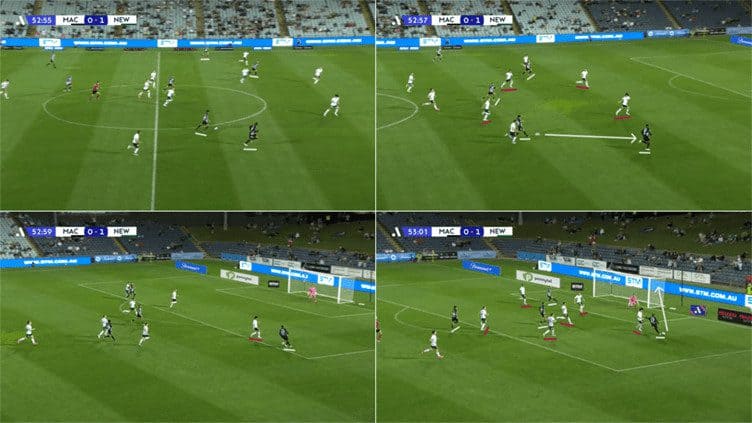
This section thus provides a sense of the basic principles that Macarthur’s offensive prowess has been predicated on. Next up, let’s look at their key contributors in attack – some of the names will ring a bell!
Goals: Valère Germain leads the charge
One of Macarthur’s most shrewd pick-ups last summer was veteran French forward Valère Germain on a free transfer. Germain, 33, was part of the famous 2016/17 AS Monaco team that won Ligue 1 and scored 10 goals in 36 league games that season. The Monaco youth product also started five of their 12 UEFA Champions League matches, scoring twice in their run to the semifinals.
The summer after that season, he moved to Olympique Marseille, where he spent four years and scored 31 times in 159 matches before moving to Montpellier in the summer of 2021. His goalscoring tally dropped to seven in 68 matches at the latter club, who chose not to renew his contract last summer.
Montpellier’s loss was Macarthur’s gain.
Germain has provided the Bulls with the answer they needed up top, scoring 10 and assisting four of their 32 A-League goals this term. He has offered variety, scoring predominantly with his left but netting penalties with his right and occasionally popping up with a header as well. His threat extends to set-pieces, while often, as the player furthest up the pitch, the Frenchman is a crucial facilitator and finisher of counterattacks as well.
Consider the following sequence from Macarthur’s match against Perth Glory, which highlights another of his key attributes: movement. Germain (marked in black) starts this play at the edge of the area when the initial pass is played out to the right. He then makes his way into the box and gets in between two defenders. Despite there seemingly being no space to burst through, that is precisely what he does to meet a lovely ball into the box and tap it into an empty net.
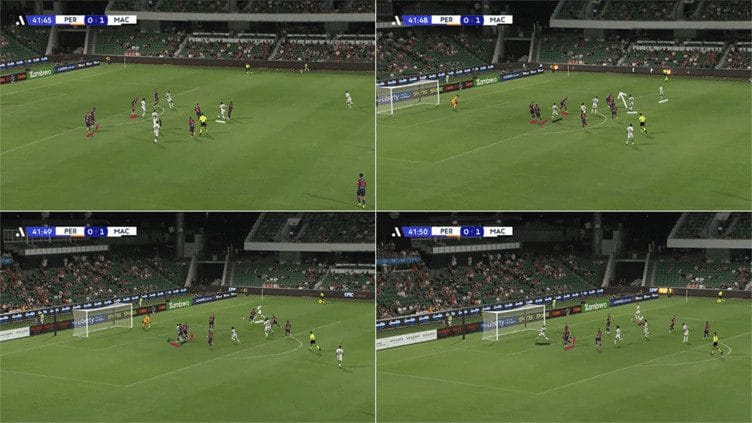
Germain’s effectiveness on the counter can be seen in the sequence below, where he starts the move with a deft touch to cushion a long ball forward from defence into the path of his winger. Germain then notices that his teammate is drifting infield and quickly changes direction to move to the right.
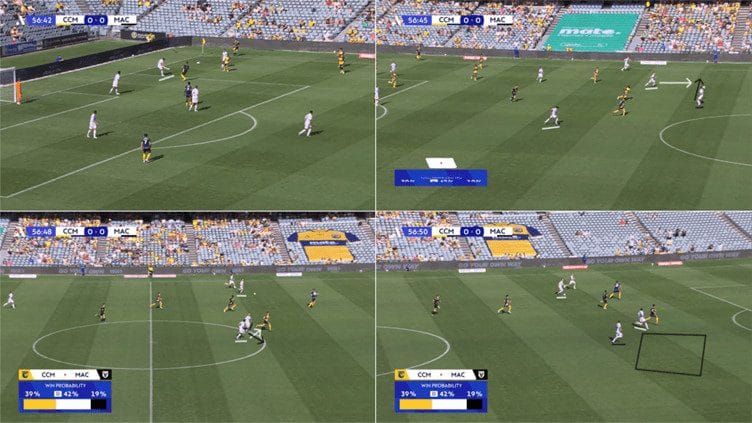
Here, he is completely open against a scrambling Central Coast Mariners defence. He calls for the ball and receives it before firing a rocket into the top corner, giving the goalkeeper no chance.
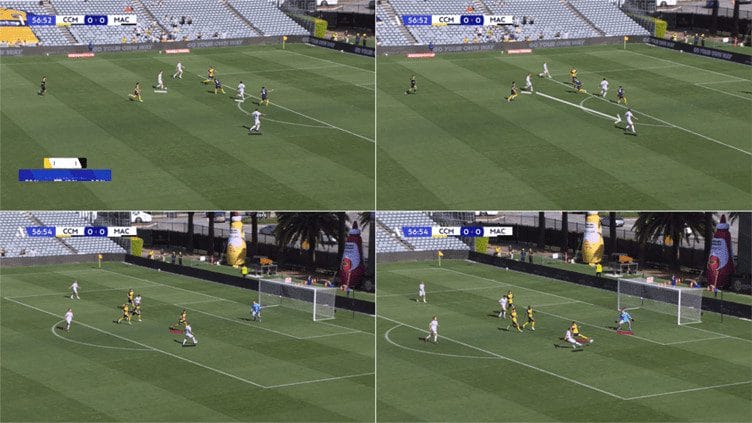
Germain’s allies: Ulises Dávila, Jake Hollman & more
Macarthur’s second-highest scorer, briefly touched upon earlier, is Dávila, who has recorded seven league goals this term. The midfielder rarely featured under Sterjovski last season but has become virtually undroppable this term and has also been named club captain.
In Dávila, the Bulls have a player who offers creativity and finishing within the box, as evidenced by his goal against Perth, while he can also help initiate passing moves in build-up. He has three assists in the A-League this term, and as his shot assist map below shows, he has the ability to create a chance from both central and wide areas.
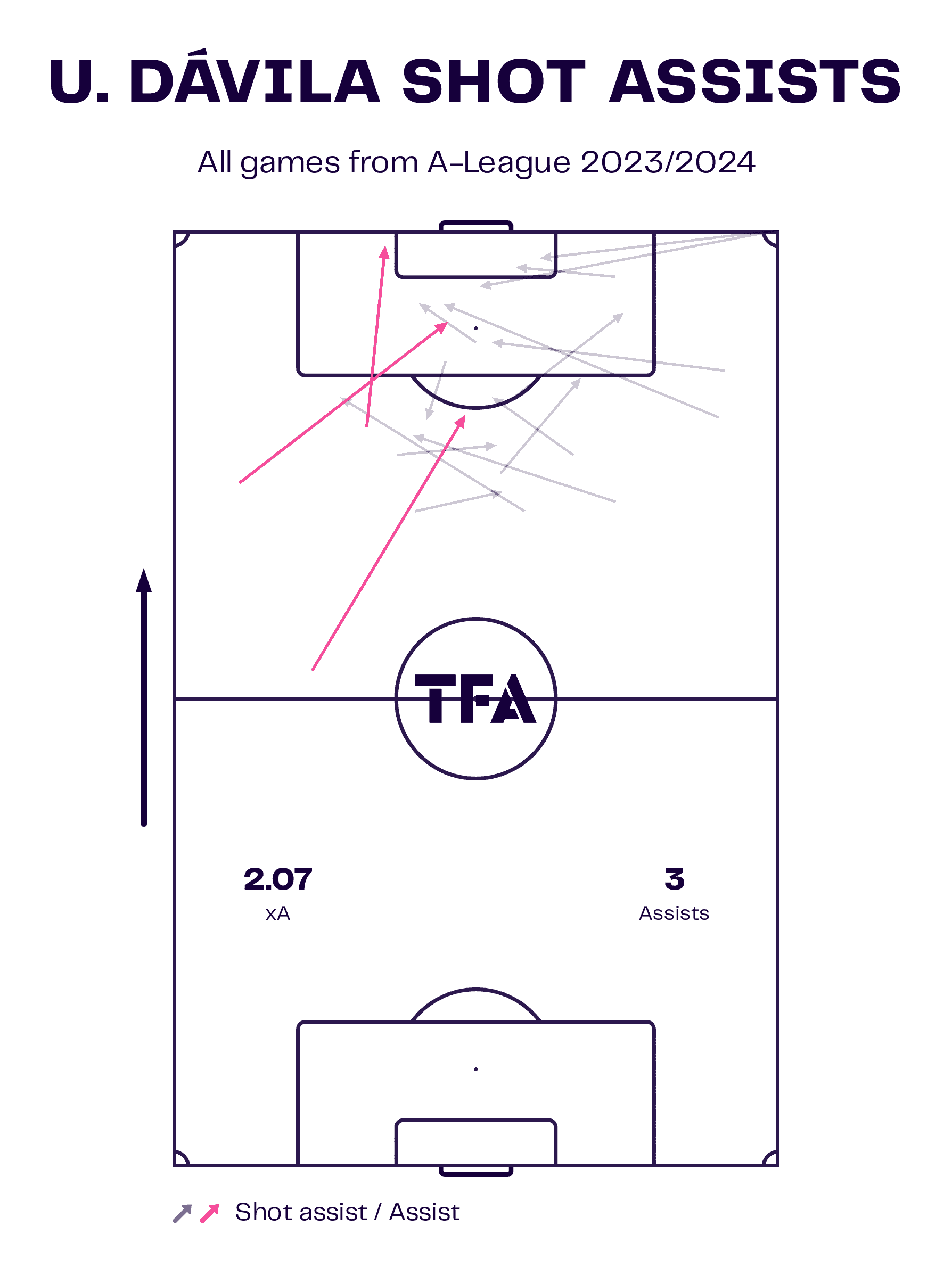
Another key source of goals for Macarthur this term has been 22-year-old midfielder Jake Hollman, who has enjoyed a breakout campaign with five goals and an assist in 17 outings. Hollman’s chances this term have primarily involved late runs into the final third, as in the goal below from their match against Sydney.
This move begins with a ball over the top from midfield into Germain, who realises that he cannot outpace the two centre-backs right alongside him. The Frenchman opts to hold the ball up and wait for runners, one of whom is Hollman, who we don’t see until the sequence on the bottom left tile. The youngster chests the ball down before bending a beautiful shot into a virtually non-existent gap between two defenders and the bottom-right corner to give his side the lead.
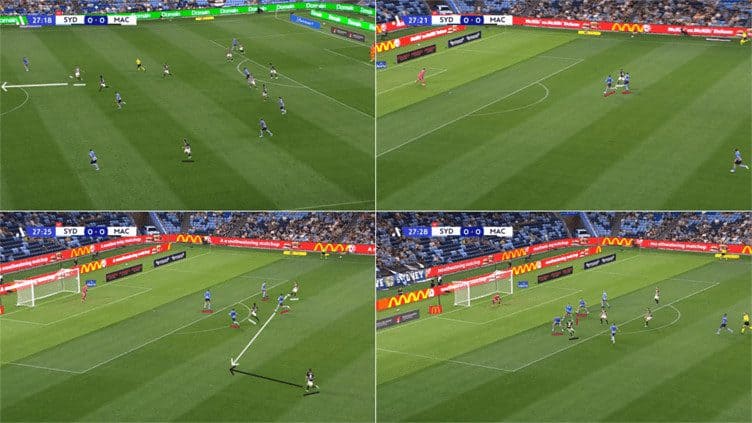
Macarthur have also had three more contributors in the goals department. The first of those has been Millar, who scored four league goals before his injury, all of which were assisted by Dávila, while Borges Rodrigues has netted thrice. Jed Drew and Kearyn Baccus have also chipped in with a goal apiece.
Conclusion
Overall, what stands out about Sterjovski’s Macarthur this season is the manner in which they’ve spread out the goalscoring burden among numerous players while also supplying their star forward with enough chances to hit double-digits. They are well on track for a top-2 finish, with a win in this weekend’s crunch fixture against the league-leading Wellington Phoenix likely to be crucial in determining their title bid.
Sterjovski receives massive credit for turning around a Bulls team that struggled for answers offensively on a consistent basis last term. They still allow quite a few goals, but right now, they’re making up for it and more with their attacking prowess. They are arguably one of the most exciting teams in the world to watch!





Comments